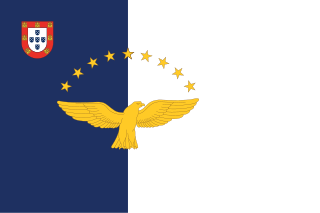
The Azores, officially the Autonomous Region of the Azores, is one of the two autonomous regions of Portugal. It is an archipelago composed of nine volcanic islands in the Macaronesia region of the North Atlantic Ocean, about 1,400 km (870 mi) west of Lisbon, about 1,500 km (930 mi) northwest of Morocco, and about 1,930 km (1,200 mi) southeast of Newfoundland, Canada.
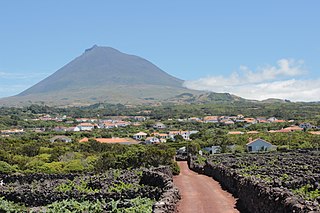
Pico Island is an island in the Central Group of the Portuguese Azores. The landscape features an eponymous volcano, Ponta do Pico, which is the highest mountain in Portugal, the Azores, and the highest elevation of the Mid-Atlantic Ridge. In the tradition of the Portuguese poet, Raul Brandão, Pico is referred to as the Ilha Preta, for its black volcanic soils, which nourish its UNESCO-designated vineyards that once allowed the development of the island's economy. Pico is the second largest and, geologically speaking, the most recently formed island of the Azores, being around 300,000 years old.

Horta is a municipality and city in the Portuguese archipelago of the Azores encompassing the island of Faial. The population in 2011 was 15,038 in an area of 173.06 square kilometres (66.82 sq mi) The city of Horta itself has a population of about 7,000.

Faial Island, also known as Fayal Island, is a Portuguese island of the Central Group or Grupo Central of the Azores, in the Atlantic Ocean.

The Capelinhos is a monogenetic volcano located on the western coast of Faial Island in the Azores. It is part of the larger volcanic complex of Capelo, which includes 20 scoria cones and lava fields that are aligned west-northwest to east-southeast from the Caldeira Volcano caldera. Although the name "Capelinhos" is associated with the volcano, it technically refers to the western cape of the parish of Capelo. It can be considered the westernmost point of Europe; there are more westerly islands in the Azores archipelago but they lie on the North American Plate.

Capelo is a freguesia in the municipality of Horta on the island of Faial in the Azorean archipelago. The population in 2011 was 486, in an area of 26.64 km2. Capelo may be considered the westernmost settlement of Eurasia, if Fajã Grande, on Flores Island, is considered part of North America, for it sits on the North American Plate.
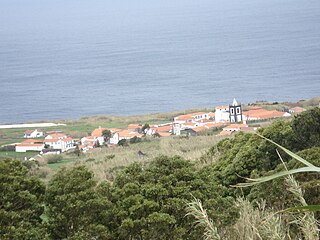
Cedros is a freguesia in the northern part of the municipality of Horta on the island of Faial in the Portuguese archipelago of the Azores. The population in 2011 was 907, in an area of 24.5 square kilometres (264,000,000 sq ft). The northernmost parish on the island, it is located 19 kilometres (12 mi) northwest of Horta and is linked via the Estrada Regional E.R. 1-1ª roadway to the rest of the island. The tree-covered hills and pasture-lands cover the interior, and hedged farmlands extend to the Atlantic coastline cliffs, a natural plateau above the sea, that was settled by early Flemish and Spanish colonists in the late part of the 15th century. Primarily an agricultural community, the population is comparable in size to other parishes on the island, though this has decreased by half since the 1950s. Today, it remains an agricultural centre of the island of Faial, anchored by the Cooperativa Agrícola dos Lactícinios do Faial, one of the primary rural industries on the island, responsible for sales of milk, cheese and butter.

Conceição is a freguesia in the municipality of Horta in the Portuguese Azores. The population in 2011 was 1,138, in an area of 3.08 km². It is the second smallest parish within the administration of Horta.

Praia do Almoxarife is a freguesia in the municipality (concelho) of Horta, of the Portuguese archipelago of the Azores. The population in 2011 was 834, in an area of 9.20 km2. Although it was the beachhead of early settlement on the island, its population has not grown significantly since it was settled. It has become an important summer destination and tourist center for its long black sand beach.
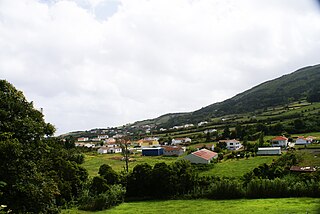
Ribeirinha is a freguesia in the municipality of Horta in the Portuguese archipelago of the Azores. The population in 2011 was 427, in an area of 12.26 km2. It contains the localities Canadinha, Chã da Cruz, Espalhafatos, Lomba dos Espalhafatos and Rua da Igreja.

The hydrothermal vents and seamounts of the Azores are a series of Atlantic seamounts and hydrothermal vents that are part of the Mid-Atlantic Ridge system, giving rise to the archipelago and bathymetric region of the Azores. These geological structures, formed from masses of basalt, are of a geomorphological interest due to their rich deposits of ore. In addition it fosters a rich ecosystem of diverse subaquatic plant and animal life. There are food chains within this environment, for example, that are purely chemosynthetic, and do not need sunlight for photosynthesis.

The Lighthouse of Ponta da Barca is a beacon/lighthouse located along the 24 metres (79 ft) cliffs of Ponta da Barca, near the hamlet of Bom Jesus, civil parish of Santa Cruz da Graciosa on the island of the same, the Portuguese archipelago of the Azores. Immediately near the lighthouse, is the emblematic baleia de pedra, a curious geological basaltic rock that has resisted erosion, in the shape of a whale. The lighthouse includes a symmetrical single-floor building, and a 23-metre (75 ft) high cylindrical tower that extends its lamp to 71 metres (233 ft) above the ocean surface. It is considered a second-order lighthouse, which began operating on 1 February 1930.

The Nature Park of Faial, or simply Faial Nature Park (PNF), developed from the intention of better managing the protected areas of the island of Faial, and was instituted by the Secretaria Regional do Ambiente e do Mar of the Autonomous Regional Government of the Azores.

The Ponta das Contendas Lighthouse is lighthouse located along the promontory of Contendas, in the civil parish of São Sebastião, municipality of Angra do Heroísmo on the island of Terceira, in the Portuguese archipelago of the Azores.
José de Almeida de Ávila was an official in the Portuguese Marines, obtaining the post of Captain, colonial administrator, Governor of Quelimane and Lourenço Marques, as well as the Civil Governor of the district of Horta.

The Lighthouse of Ponta Garça is a beacon/lighthouse located along cliffs of the civil parish of Ponta Garça in the municipality of Vila Franca do Campo, in the Portuguese archipelago of the Azores. The lighthouse was built in the 20th century, and consists of a circular tower and rectangular communications block, comparable to other lighthouses in the archipelago, namely Ponte do Cintrão and Ponta do Rosais.
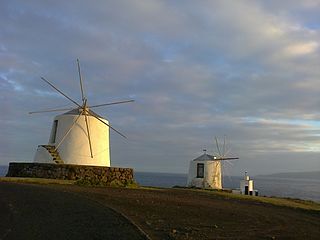
The Lighthouse of Ponta Negra is a beacon/lighthouse located along the cliffs of promontory of Ponta Negra, in the municipality of Vila do Corvo, on the Portuguese island of Corvo, in the archipelago of the Azores.

The Lighthouse of Vale Formoso is a beacon/lighthouse located along the southwestern cliffs of the civil parish of Capelo, in the municipality of Horta, on the Portuguese island of Faial, in the archipelago of the Azores.
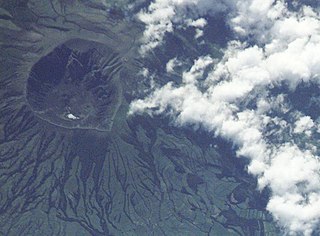
The Caldeira Volcano is the highest mountain, massive stratovolcano and the largest geomorphological structure that forms the island of Faial. The mountain's highest point, Cabeço Gordo, reaches 1,043 metres (3,422 ft) above sea level. One of the most notable features of this volcano is its two kilometer wide caldera, that is 400 m (1,300 ft) in depth below the crater rim.






















